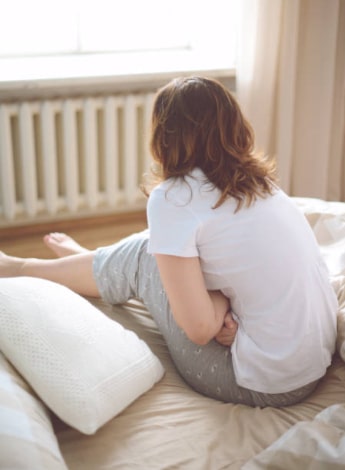
Five facts about … female pelvic health

To celebrate International Women’s Day 2021, Lauren Neill, Georgia Feben, Tarryn Lawrence, Alexandra Diggles and Brooke Dobo present five discussion points about the role of physiotherapy in assisting women to address and improve their pelvic health so that it isn’t a barrier to them moving toward gender parity.
1. Early intervention and management of pelvic organ prolapse can improve quality of life
Pelvic organ prolapse (POP) occurs when one or more of the pelvic organs descend into the vagina.
This causes symptoms of heaviness, dragging, bulge, or pressure. POP is estimated to affect more than half of women who have had a baby, significantly impacting on their quality of life (QOL).
However, only one in five women seek medical help for their symptoms.
A suitably trained physiotherapist is able to assist management of POP by:
- educating lifestyle modifications to reduce symptoms such as weight loss, treating constipation, avoiding straining and heavy lifting (Grade C recommendation)
- teaching pelvic floor muscle training individualised to the woman (Grade A recommendation)
- fitting vaginal pessaries to support the prolapse (Grade B recommendation, if fitted correctly)
- providing prolapse-friendly exercises and activities to meet national physical activity guidelines, and teach ‘The Knack’
- discussing medical options such as local oestrogen (Grade B recommendation) or surgical outcome rates, which are often better if pelvic floor training is commenced prior to surgery.
Although not life-threatening, prolapse symptoms can negatively affect a woman’s biopsychosocial wellbeing.
Therefore, education regarding prevention, particularly for early postnatal mothers, and early diagnosis and management for women with symptoms can have dramatic impacts on QOL.
2. First-line interventions can enhance management of urinary incontinence symptoms
Urinary incontinence (UI) is the complaint of an involuntary loss of urine.
UI affects all genders; however, women are more commonly affected. Some risk factors for development of UI include pregnancy and childbirth, obesity, menopause, certain types of surgery and some neurological and musculoskeletal conditions.
UI is common and affects up to 30 per cent of women, many of whom ‘put up’ with their symptoms because they think it is normal or not enough to warrant intervention.

Research shows that women with UI have significantly poorer QOL compared with their continent counterparts and it commonly contributes to psychological morbidity.
In addition to this, up to 23 per cent of women take time off work due to their UI, and 38 per cent of women report that it has a negative impact on their relationships.
Physiotherapists are well placed to provide first-line intervention to assist women to manage their UI symptoms. This can then result in improvements in their QOL and participation in social and work environments.
Physiotherapy intervention can include a thorough assessment to determine the likely cause of the UI, education, individualised pelvic floor muscle training (Grade A recommendation), continence pessaries, bladder retraining and lifestyle advice.
3. A targeted approach is essential in the management of faecal incontinence
Problems with bowel control, termed faecal or anal incontinence (FI), are associated with a significant burden to a person’s QOL.
It is estimated that between two and 20 per cent of the general population experience FI; however, many do not report bowel concerns. And only one in four will seek help.
Risk factors for development of FI include previous obstetric birth injuries (eg, third and fourth degree tears), chronic constipation, a history of bowel surgery and some inflammatory bowel and neurological conditions.
A study has shown that people experiencing FI are four times more likely to be afflicted with anxiety, and five times more likely to be affected by depression, with FI sufferers also being more likely to report anxiety, frustration and shame.
In addition to the psychological affects, having FI can lead to reduced participation in work and social aspects of life further contributing to inequality.

Management of FI by suitably trained physiotherapists can involve education regarding stool type modification, retraining the pelvic floor muscles, coordination of muscles to relax during defecation, correct toileting postures and assessment of possible prolapse.
Physiotherapists working in this area can also help to identify when referrals to other health professionals such as colorectal specialists and dietitians is indicated.
4. Identifying biopsychosocial factors can improve management of pelvic pain
Pelvic pain (PP) is defined as pain located between the umbilicus to the mid-thigh.
In the pelvis, visceral and myofascial nociception can be diffuse and poorly localised. PP often interferes with pelvic floor muscle, bladder, bowel and sexual function.
One in four women and one in six men will experience persistent PP.
Some common conditions include endometriosis, bladder pain syndrome/interstitial cystitis, proctalgia fugax and pudendal neuralgia. In all of these conditions, pelvic floor muscle dysfunction occurs in 70–90 per cent of patients.
Similar to other persistent pain conditions, physiotherapy management should identify all biopsychosocial factors.
In both men and women, there are higher rates of co-morbid psychosocial conditions such as depression and anxiety.
In women, there is a higher prevalence of other conditions such as fibromyalgia, temporomandibular joint disorder and migraine.
Addressing pelvic floor muscle dysfunction results in significant changes to QOL and pain reporting.
This can be achieved by improving motor control with pelvic floor relaxation and biofeedback training, manual therapy to improve range of motion and distensibility, pain education, paced and gradual return to exercise, and improved bladder and bowel functioning.
Working collaboratively with a women’s, men’s and pelvic health physiotherapist can assist in providing a detailed assessment of the pelvic floor muscles and guidance to managing PP conditions.
5. Physios play a vital role in after birth and surgery recovery
Thanks to advocacy work of the APA and other governing bodies such as the Continence Foundation of Australia, it is now fairly common knowledge that one in three women who have had a baby will leak urine.
What is not common knowledge is research-based evidence that pelvic floor muscle training supervised by a trained physiotherapist significantly reduces the risk of pelvic floor dysfunction in the postpartum population.
A postnatal physiotherapy assessment includes detailed questioning to determine the individual woman’s goals and may involve an internal pelvic floor assessment, abdominal wall and/or musculoskeletal assessment.
Physiotherapy intervention may also assist postpartum women suffering from inflammatory conditions of the lactating breast, such as mastitis.
Women recovering from vaginal or caesarean deliveries can greatly benefit from the guidance of their physiotherapist.
Evidence and clinical guidelines have given rise to screening tools and up-to-date advice and education, which can greatly benefit new mothers in their postpartum recovery.
Physiotherapy can also assist in the recovery following gynaecological surgery such as hysterectomy or prolapse surgery.
Evidence suggests that pelvic floor physiotherapy before and after surgery may help to prevent recurrent symptoms, and optimal post-surgical reconditioning is crucial for women to be able to return to their lives including work and exercise.
Click here for an infographic poster version of this article.
Lauren Neill, APA Continence and Women’s Health Physiotherapist, is the senior women’s, men’s and pelvic health physiotherapist at Physio Plus and Mackay Mater Private Hospital.
Georgia Feben, APAM, is a physiotherapist working in private practice on the Gold Coast, specifically in women’s health.
Tarryn Lawrence, APAM, is the current chair of the APA Women’s, Men’s and Pelvic Health Committee, and works in an advanced role in the Women’s, Men’s and Pelvic Health Physiotherapy Service at Logan Hospital.
Alexandra Diggles, APA Continence and Women’s Health Physiotherapist and APA Pain Physiotherapist, has recently started working in her own private practice in Brisbane.
Brooke Dobo, APAM, is a women’s, men’s and pelvic health physiotherapist currently working at The Wesley Hospital, Brisbane, with a special interest in ante/postnatal care, pelvic pain and sexual dysfunction.
- References
Fact 1
Abrams, P., et al. (2017). 6th International Consultation on Incontinence - Recommendations of the International Scientific Committee: Evaluation and treatment of urinary incontinence, pelvic organ prolpase and faecal incontinence, Health Publications Ltd Paris.
- Dumoulin, C., et al. (2016). 'Conservative management for female urinary incontinence and pelvic organ prolapse review 2013: Summary of the 5th Internal Consultation on Incontinence ', Neurourology Urodynamics, vol. 35, pp. 15-20.
- Hagen, S & Thakar, R (2015). 'Conservative management of pelvic organ prolapse', Obstetrics, Gynaecology & Reproductive Medicine, vol. 25, no. 4, pp. 91-5.
- Vergeldt, TF, Weemhoff, M, IntHout, J & Kluivers, KB (2015). 'Risk factors for pelvic organ prolapse and its recurrence: a systematic review', Int Urogynecol J, vol. 26, no. 11, pp. 1559-73.
Fact 2
Margareta, N., Ann, L., & Othon, L. (2009). The impact of female urinary incontinence and urgency on quality of life and partner relationship. Neurourology and Urodynamics: Official Journal of the International Continence Society, 28(8), 976-981.
Coyne, K. S., et al. (2004). The impact of urinary urgency and frequency on health‐related quality of life in overactive bladder: results from a national community survey. Value in health, 7(4), 455-463.
Haylen, B. T., et al. (2010). An International Urogynecological Association (IUGA)/International Continence Society (ICS) joint report on the terminology for female pelvic floor dysfunction. Neurourology and Urodynamics: Official Journal of the International Continence Society, 29(1), 4-20.
Fact 3
Abrams, P., et al. (2010). Fourth International Consultation on Incontinence Recommendations of the International Scientific Committee: Evaluation and treatment of urinary incontinence, pelvic organ prolapse, and fecal incontinence. Neurourology and urodynamics, 1;29(1):213-40.
Kuoch, K. L., Hebbard, G. S., O’Connell, H. E., Austin, D. W., & Knowles, S. R. (2019). Urinary and faecal incontinence: psychological factors and management recommendations. NZ Med J, 132, 25-33.
Fact 4
Armour M, et al. (2019). The cost of illness and economic burden of endometriosis and chronic pelvic pain in Australia: A national online survey. PLoS One ;14(10):e0223316. doi: 10.1371/journal.pone.0223316. PMID: 31600241; PMCID: PMC6786587.
Pitts M, Ferris J, Smith A, Shelley J, Richters J. (2008). Prevalence and correlates of three types of pelvic pain in a nationally representative sample of Australian men. J Sex Med. 5(5):1223-1229. doi: 10.1111/j.1743-6109.2007.00784.x. Epub 2008 Mar 4. PMID: 18331265.
Fact 5
Lakeman, M. M., et al. (2013). Peri-operative physiotherapy to prevent recurrent symptoms and treatment following prolapse surgery: supported by evidence or not?. International urogynecology journal, 24(3), 371-375.
Wesnes, S. L., & Lose, G. (2013). Preventing urinary incontinence during pregnancy and postpartum: a review. International urogynecology journal, 24(6), 889-899.
© Copyright 2025 by Australian Physiotherapy Association. All rights reserved.





